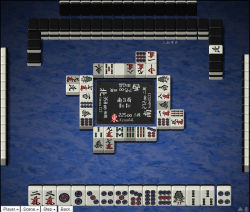Sanshoku doujun: Difference between revisions
mNo edit summary |
mNo edit summary |
||
| (12 intermediate revisions by 4 users not shown) | |||
| Line 9: | Line 9: | ||
* [http://tenhou.net/0/?log=2013111613gm-0009-7447-5dc14720&tw=0&ts=3 Closed sanshoku] with [[junchan]] | * [http://tenhou.net/0/?log=2013111613gm-0009-7447-5dc14720&tw=0&ts=3 Closed sanshoku] with [[junchan]] | ||
}} | }} | ||
'''Sanshoku doujun''' | '''Sanshoku doujun''' {{kana|三色同順}} is a standard yaku. It can also be referred as '''sanshiki''' {{kana|さんしき}}. This yaku involves [[Shuntsu|sequences]] of the same numbered tiles across the three [[Japanese mahjong#Mahjong tiles|numbered suits]]. The short hand '''sanshoku''' more commonly refers to this yaku, rather than the significantly more difficult to achieve [[sanshoku doukou]] yaku. This yaku simply happens more frequently. | ||
==Tile pattern== | ==Tile pattern== | ||
{{#mjt:123m123p123678s1z}} | {{#mjt:123m123p123678s1z}} Agari : {{#mjt:1z}} | ||
This hand contains shuntsu of 123 from 3 different [[Japanese mahjong#Mahjong tiles|main suits]]. Since this hand played closed, it's sanshoku valued 2 han. | This hand contains shuntsu of 123 from 3 different [[Japanese mahjong#Mahjong tiles|main suits]]. Since this hand played closed, it's sanshoku valued 2 han. | ||
{{#mjt:123m123p123s1z}} {{#mjt:6'78s}} | {{#mjt:123m123p123s1z}} {{#mjt:6'78s}} Agari : {{#mjt:1z}} | ||
{{#mjt:123p67s11z}} {{#mjt:1'23m}} {{#mjt:3'12s}} | {{#mjt:123p67s11z}} {{#mjt:1'23m}} {{#mjt:3'12s}} Agari : {{#mjt:8s}} or {{#mjt:5s}} | ||
While having same tiles with the first example, these hands played open and hence the sanshoku only valued 1 han. | While having same tiles with the first example, these hands played open and hence the sanshoku only valued 1 han. | ||
== | == Compatibility == | ||
{{main|Yaku compatibility}} | |||
{{Yaku compatibility table|SDJ}} | |||
Sanshoku requires three sequence groups, and thus is incompatible with [[toitoi]], [[sanshoku doukou]], [[sanankou]], [[sankantsu]], [[shousangen]], [[honroutou]], and [[chiitoitsu]]. It is incompatible with [[honroutou]] because honroutou requires either toitoi or chiitoi. Since it requires three suits, it is also incompatible with [[honitsu]] and [[chinitsu]]. Finally, while [[ryanpeikou]] and [[ittsu]] do each require sequences, their constraints on the sequences are incompatible with those for sanshoku. | |||
===Takame and yasume=== | |||
{{main|Takame and yasume}} | |||
Sanshoku is particularly affected by [[takame and yasume]]. At times, the tile wait involves a ryanmen looking for two tile types for the third tile grouping needed for this yaku. In this case, one may result in sanshoku, while the other does not; and the difference here may involve 1 or 2 han. | |||
:{{#mjt:456m456s45p22266z}} Agari: {{#mjt:3p}} or {{#mjt:6p}} | |||
Only the 6-pin produces sanshoku in this case. | |||
== | ===Versus ittsu=== | ||
{{main| | {{main|Ittsu vs sanshoku}} | ||
[[Image:Ittsu sanshoku.png|thumb|right|250px|Both ittsu and sanshoku are [http://tenhou.net/0/?log=2015012320gm-0089-0000-5a33fc94&tw=2&ts=8 apparent].]] | |||
It is possible for both yaku to have potential development in one hand. However, there is no room in the hand for both yaku to exist. So, when both yaku are apparent, then a point may come during the hand to make a choice between each of the two yaku. | |||
==Value== | |||
This yaku is subject to [[kuisagari]]. When closed, the yaku is worth 2 hand, but it reduces by 1 han when open. | |||
==External links== | ==External links== | ||
Revision as of 02:24, 28 February 2023
| Type | Yaku |
|---|---|
| Kanji | 三色同順 |
| English | Three colored straight |
| Value |
2 han (closed) 1 han (open) |
| Speed | Medium |
| Difficulty | Medium |
Sanshoku doujun 「三色同順」 is a standard yaku. It can also be referred as sanshiki 「さんしき」. This yaku involves sequences of the same numbered tiles across the three numbered suits. The short hand sanshoku more commonly refers to this yaku, rather than the significantly more difficult to achieve sanshoku doukou yaku. This yaku simply happens more frequently.
Tile pattern
This hand contains shuntsu of 123 from 3 different main suits. Since this hand played closed, it's sanshoku valued 2 han.
While having same tiles with the first example, these hands played open and hence the sanshoku only valued 1 han.
Compatibility
^ Ippatsu requires riichi to be of any use.
| RCH | DRI | IPP | SMO | TAN | PFU | IPK | ITT | YAK | SDJ | SDO | TOI | SNA | SNK | CHA | JUN | RPK | SSG | HRO | HON | CHN | CHI | RIN | HAI | HOU | CHK | |
| SDJ |
Sanshoku requires three sequence groups, and thus is incompatible with toitoi, sanshoku doukou, sanankou, sankantsu, shousangen, honroutou, and chiitoitsu. It is incompatible with honroutou because honroutou requires either toitoi or chiitoi. Since it requires three suits, it is also incompatible with honitsu and chinitsu. Finally, while ryanpeikou and ittsu do each require sequences, their constraints on the sequences are incompatible with those for sanshoku.
Takame and yasume
Sanshoku is particularly affected by takame and yasume. At times, the tile wait involves a ryanmen looking for two tile types for the third tile grouping needed for this yaku. In this case, one may result in sanshoku, while the other does not; and the difference here may involve 1 or 2 han.
Only the 6-pin produces sanshoku in this case.
Versus ittsu

It is possible for both yaku to have potential development in one hand. However, there is no room in the hand for both yaku to exist. So, when both yaku are apparent, then a point may come during the hand to make a choice between each of the two yaku.
Value
This yaku is subject to kuisagari. When closed, the yaku is worth 2 hand, but it reduces by 1 han when open.
External links
- Sanshoku doujun in Japanese Wikipedia
| |||||||||||||||||||||||||||||||
